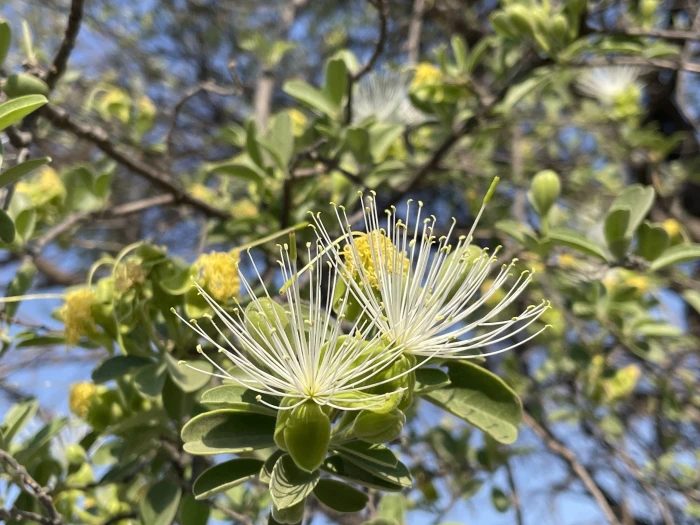Angola Caper
(Maerua angolensis)
Angola Caper (Maerua angolensis)
/
/

Robert Taylor
CC BY 4.0
Image By:
Robert Taylor
Recorded By:
Copyright:
CC BY 4.0
Copyright Notice:
Photo by: Robert Taylor | License Type: CC BY 4.0 | License URL: http://creativecommons.org/licenses/by/4.0/ | Rights Holder: Robert Taylor | Publisher: iNaturalist | Date Created: 2022-10-02T06:20:18Z |

























Estimated Native Range
Climate Requirements for Gasteiz / Vitoria, Spain
| This Plant | Your Site | Plant Suitability for Your Location | ||
|---|---|---|---|---|
| • Precipitation | 3" - 74" | 32" | Your precipitation may be too high for this plant. | Too high |
| • High Temp. | 67°F - 111°F | 78°F | Your summer temperatures are normal for this plant. | Excellent |
| • Low Temp. | 37°F - 73°F | 34°F | Your winter temperatures may be too cold for this plant | Too cold |
This plant may not grow well at your location - your precipitation is too high.
Summary
Maerua angolensis, commonly known as the Angola Caper, is a deciduous tree native to a variety of habitats including dry woodland, bushveld, and areas surrounding seasonal watercourses in tropical Africa. It is found at elevations up to 5906 feet, particularly in countries like Kenya, Tanzania, Zambia, Zimbabwe, and South Africa. The Angola Caper can grow up to 33 feet tall with a rounded crown and typically has smooth grey bark with distinctive yellowish-orange patches. Its leaves are soft and drooping, providing a gentle texture to the landscape. The fragrant, cream-colored flowers are pincushion-like and bloom at the beginning of the rainy season, offering a showy display that attracts pollinators. Following flowering, the tree produces torulose fruits that resemble a string of beads, adding further interest to the plant’s appearance.
The Angola Caper is valued for its drought tolerance and ability to thrive in arid conditions, making it suitable for xeriscaping and as a feature tree in water-conserving gardens. It is also used for its medicinal properties; the leaves are consumed as a food supplement during famine and have traditional uses in treating anorexia and promoting wound healing. Additionally, it serves as a food source for game and livestock, and its foliage is a host for butterflies of the Pieridae family. In cultivation, it requires well-drained soil, tolerates a range of soil types, and prefers full sun to partial shade. While it is not commonly grown in cultivation outside its native range, it has potential for use in dry tropical and subtropical landscapes.CC BY-SA 4.0
The Angola Caper is valued for its drought tolerance and ability to thrive in arid conditions, making it suitable for xeriscaping and as a feature tree in water-conserving gardens. It is also used for its medicinal properties; the leaves are consumed as a food supplement during famine and have traditional uses in treating anorexia and promoting wound healing. Additionally, it serves as a food source for game and livestock, and its foliage is a host for butterflies of the Pieridae family. In cultivation, it requires well-drained soil, tolerates a range of soil types, and prefers full sun to partial shade. While it is not commonly grown in cultivation outside its native range, it has potential for use in dry tropical and subtropical landscapes.CC BY-SA 4.0
Plant Description
- Plant Type: Tree, Shrub
- Height: 6-18 feet
- Width: 4-10 feet
- Growth Rate: Moderate
- Flower Color: White
- Flowering Season: Spring
- Leaf Retention: Deciduous
Growth Requirements
- Sun: Full Sun, Part Shade
- Water: Low
- Drainage: Medium, Fast
Common Uses
Drought Tolerant, Edible*Disclaimer: Easyscape's listed plant edibility is for informational use. Always verify the safety and proper identification of any plant before consumption., Low Maintenance
Natural Habitat
Native to dry woodland, bushveld, and areas surrounding seasonal watercourses in tropical Africa
Other Names
Common Names: Bushveld Maerua, Cabbage tree, Angola mustard
Scientific Names: Maerua angolensis
GBIF Accepted Name: Maerua angolensis